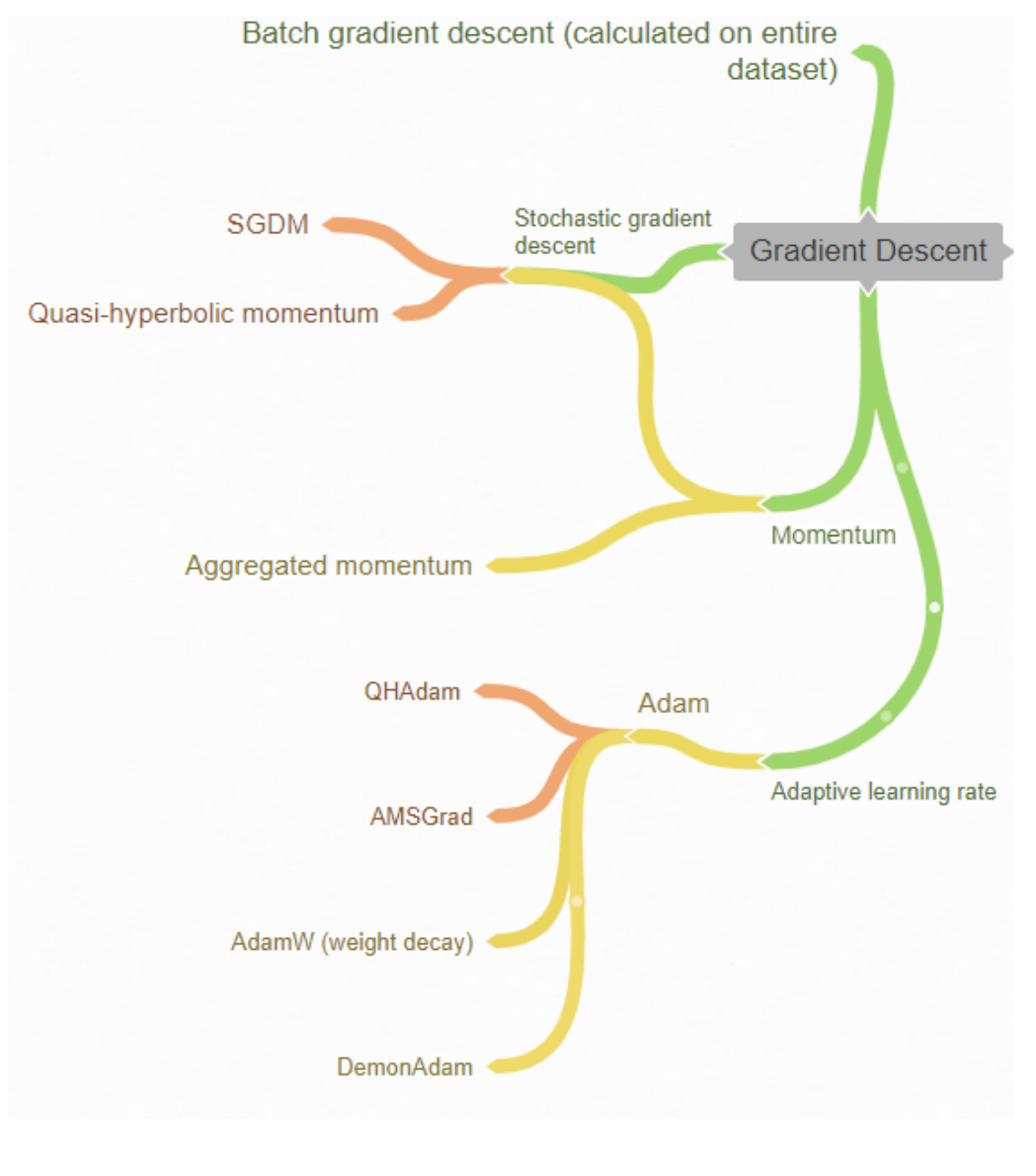This study investigates optimization algorithms in Deep Learning, focusing on Gradient Descent. We explore different tasks, including Image and Text classification, as well as Image generation, employing 9 distinct optimization algorithms. The findings indicate that Adam-based techniques, such as QHAdam, AdamW, and Demon Adam, frequently outperform other methods in terms of learning effectiveness.
For this experiment, we utilize the CIFAR10 dataset. To assess both small and large model architectures, we employ LeNet and ResNet.
| LeNet/ResNet | Valid acc | Valid F1 | Test acc | Test F1 | Valid acc | Valid F1 | Test acc | Test F1 | Time complexity (s/epoch) |
|---|---|---|---|---|---|---|---|---|---|
| SGDM | 65.600 | 65.325 | 65.260 | 65.152 | 74.020 | 73.615 | 73.110 | 72.847 | 6.992/15.205 |
| Adam | 65.700 | 65.453 | 64.160 | 64.123 | 75.160 | 74.954 | 75.070 | 74.985 | 7.135/16.079 |
| AggMo | 65.560 | 65.031 | 65.490 | 65.109 | 72.760 | 72.367 | 71.990 | 71.641 | 6.966/16.027 |
| QHM | 67.220 | 66.638 | 65.860 | 65.523 | 74.320 | 74.064 | 73.140 | 73.000 | 7.111/16.006 |
| DemonSGD | 65.440 | 65.350 | 65.070 | 65.118 | 73.100 | 72.627 | 73.280 | 73.118 | 7.149/15.622 |
| AMSGrad | 65.020 | 64.684 | 64.700 | 64.700 | 75.120 | 74.793 | 73.660 | 72.512 | 7.313/15.965 |
| QHAdam | 65.340 | 64.953 | 64.600 | 64.554 | 75.560 | 75.672 | 75.130 | 75.428 | 7.277/16.959 |
| DemonAdam | 65.280 | 64.847 | 65.270 | 64.995 | 75.260 | 75.106 | 74.200 | 74.235 | 8.533/16.660 |
| AdamW | 64.540 | 64.081 | 63.110 | 62.755 | 76.000 | 75.885 | 75.030 | 75.081 | 8.294/16.723 |
We use the IMDB dataset for sentiment analysis, experiments are conducted using LSTM and BERT models.
| BERT/LSTM | Valid acc | Valid F1 | Test acc | Test F1 | Valid acc | Valid F1 | Test acc | Test F1 |
|---|---|---|---|---|---|---|---|---|
| SGDM | 81.200 | 81.199 | 80.900 | 80.898 | 79.000 | 78.985 | 79.790 | 79.783 |
| Adam | 81.175 | 81.083 | 82.090 | 82.022 | 82.000 | 81.970 | 81.470 | 81.439 |
| AggMo | 81.450 | 81.422 | 81.170 | 81.151 | 81.700 | 81.697 | 80.620 | 80.618 |
| QHM | 81.475 | 80.459 | 80.480 | 80.475 | 81.250 | 81.248 | 81.420 | 81.481 |
| DemonSGD | 82.525 | 82.521 | 82.510 | 82.508 | 80.050 | 80.047 | 79.460 | 79.460 |
| AMSGrad | 81.575 | 81.493 | 82.040 | 81.979 | 82.625 | 82.625 | 81.950 | 81.950 |
| QHAdam | 80.575 | 82.541 | 82.790 | 82.762 | 82.325 | 82.303 | 82.070 | 82.047 |
| DemonAdam | 81.425 | 81.353 | 82.380 | 82.316 | 82.200 | 82.197 | 81.890 | 81.888 |
| AdamW | 80.600 | 80.516 | 82.010 | 81.949 | 82.075 | 82.074 | 81.410 | 81.410 |
In this task, we use the MNIST dataset to investigate the optimization algorithms. VAE model is conducted to generate data.
| Optimizer | FID | IS | Time complexity (min) |
|---|---|---|---|
| SGDM | 93.535 | 2.090 | 4.403 |
| DemonSGDM | 82.751 | 2.197 | 4.447 |
| DemonAdam | 74.398 | 2.256 | 4.646 |
| Adam | 74.447 | 2.151 | 4.565 |
| AMSGrad | 74.511 | 2.220 | 5.696 |
| QHAdam | 71.718 | 2.208 | 4.815 |
| QHM | 95.078 | 2.043 | 4.502 |
| AggMo | 99.923 | 2.077 | 4.543 |
| AdamW | 74.028 | 2.262 | 4.548 |
- All methods using the adaptive learning rate technique are sensitive to the large value of the initial learning rate.
- QHM-based algorithms show effective and stable performance in all scenarios.
- SGDM is the fastest optimizer since it contains a lack of overhead computation.
More details can be found in our technical report.
In this project, we surveyed gradient descent optimization algorithms. They are all techniques that have become popular in recent times. The experimental results show that: Methods belonging to the adaptive learning rate group give better performances. The Adam-based methods are often the leading methods of learning effectiveness (QHAdam, AdamW, Demon Adam). In addition, Demon’s decay momentum strategy also showed a clear effect when significantly improving the original versions of SGDM and Adam.
This work is done at Hanoi University of Science and Technology (HUST)
If you have any discussion, please contact via nam.lh173264@gmail.com
